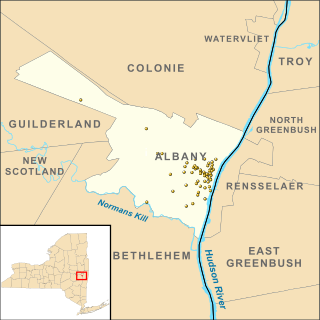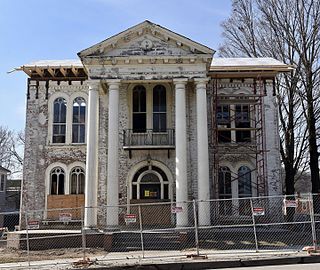
Marshall is a city in Saline County, Missouri, United States. The population was 13,806 at the 2020 census. It is the county seat of Saline County. The Marshall Micropolitan Statistical Area consists of Saline County. It is home to Missouri Valley College.

This is intended to be a complete list of properties and districts listed on the National Register of Historic Places in Orleans County, New York. The locations of National Register properties and districts may be seen in a map by clicking on "Map of all coordinates". Two listings, the New York State Barge Canal and the Cobblestone Historic District, are further designated a National Historic Landmark.

Chatham–Arch is a neighborhood located immediately east of Downtown Indianapolis, Indiana, United States. This neighborhood is one of the oldest in Indianapolis, dating back to the mid 19th century. Chatham–Arch contains many of Indianapolis's historic homes.

Windham Center Historic District is a 205-acre (83 ha) area in the town of Windham, Connecticut, that is designated as a historic district. The district was listed on the National Register of Historic Places in 1979. At the time, it included 61 contributing buildings out of a total of 78 buildings, and it included 2 other contributing sites.

East Campus is a neighborhood of Columbia, Missouri directly east of the University of Missouri and downtown Columbia. The area contains historic residential property as well many Greek student organizations houses. The district contains parts of Stephens College, the Boone Hospital Center's campus and the historic Lee Street Deli. It developed between about 1895 and 1945, and includes representative examples of Tudor Revival, Colonial Revival, and Bungalow / American Craftsman style architecture.
Charles Emmett Cassell was a Baltimore, Maryland-based architect.

There are 77 properties listed on the National Register of Historic Places in Albany, New York, United States. Six are additionally designated as National Historic Landmarks (NHLs), the most of any city in the state after New York City. Another 14 are historic districts, for which 20 of the listings are also contributing properties. Two properties, both buildings, that had been listed in the past but have since been demolished have been delisted; one building that is also no longer extant remains listed.

The Fairmount Historic District is a 409-acre (166 ha) historic district located along County Route 517 in the Fairmount section of Tewksbury Township, near Califon, in Hunterdon County, New Jersey. It was added to the National Register of Historic Places on December 20, 1996 for its significance in architecture, exploration/settlement, and industry. The district includes 72 contributing buildings that were deemed to be contributing to the historic character of the area, plus five contributing structures, nine contributing sites, and one contributing object. One contributing building is located in Washington Township, Morris County.
Frederick Adolph Brinkman was an American architect based in Kalispell, Montana, and Brinkman and Lenon is a partnership in which he worked. More than a dozen of Brinkman's extant works in and around Kalispell have been listed on the National Register of Historic Places, including the Anderson Style Shop, Charles Boles House, Brice Apartments, City Water Department, Cornelius Hedges Elementary School, Russell School, Linderman School, the Montgomery Ward Store in Kalispell, and the O'Neil Print Shop.

Woodsdale–Edgewood Neighborhood Historic District is a national historic district located at Wheeling, Ohio County, West Virginia. The district encompasses 969 contributing buildings and is primarily residential, developed between 1888 and 1945. A number of popular architectural styles are represented including Shingle Style, Queen Anne, Tudor Revival, American Foursquare, Colonial Revival and Bungalow style. The district also includes four Lustron houses. Notable non-residential buildings include the Edgwood Christian Mission Alliance Church (1932), St. John's Episcopal Chapel (1913), Mount Carmel Monastery (1915) designed by Frederick F. Faris (1870-1927), and Good Shepherd Home (1912). Also located in the district are the separately listed H. C. Ogden House and William Miles Tiernan House.

The Old Mt. Carmel Cemetery, Wrought-Iron Cross Site, near Balta, North Dakota, is a historic site of wrought-iron crosses that was listed on the National Register of Historic Places in 1989. The listing included six contributing objects.

Mount Zion Church and Cemetery is a historic church and cemetery located east of Hallsville in Boone County, Missouri. The Gothic Revival style frame church was built in 1903. It was the location of the Battle of Mount Zion Church during the American Civil War. The cemetery contains over seven hundred grave sites, including many American Civil War soldiers. The grounds contain a memorial to the Missouri State Guard. The church is still functioning today.
Mount Carmel is a ghost town in Jefferson Davis County, Mississippi, United States.

Mount Carmel Historic District is a national historic district located at Mount Carmel, McCormick County, South Carolina. The district encompasses 40 contributing buildings in Mount Carmel. They were built between 1885 and 1920, and include residential, commercial, institutional, religious, and industrial buildings. Notable buildings include Baker's Store, John Cade House, John W. Morrah House (1896), and the Mount Carmel Presbyterian Church.
Mount Vernon Springs Historic District is a national historic district located near Bonlee, Chatham County, North Carolina. The district encompasses 23 contributing buildings, 3 contributing sites, and 7 contributing structures in the rural village of Mount Vernon Springs. The village grew up near a locally famous mineral spring. Notable buildings include the Greek Revival style Female Dormitory of the Baptist Academy (1855), Gothic Revival style Mt. Vernon Springs Presbyterian Church (1885), the John C. Kirkman House, Robert P. Johnson House, and John M. Foust House. Also located in the district are the Mt. Vernon Springs, the Baptist Academy Cemetery, and the Mt. Vernon Springs Presbyterian Church cemetery.

Historic District E is a national historic district located at Boonville, Cooper County, Missouri. It encompasses 88 contributing buildings in a predominantly residential section of Boonville. The district includes representative examples of Late Victorian style architecture. Notable buildings include the Dyer Residence (1870), Burns Residence, Rennison Residence (1890s), Lauer Residence (1830-1833), Robinson Residence (1905), Bell Residence (1886), Schuster Residence (1833), Kempf Residence (1890s), Cooper County Court Property, Morgan Street Baptist Church (1884), Waible Residence (1833-1848), and United Church of Christ.

Luce-Dyer House, also known as the Stark-Carlson House, is a historic home located at Louisiana, Pike County, Missouri. It was built between about 1856 and 1860, and is a two-story, three-bay, Italianate style brick dwelling. It features a bracketed cornice, gabled roofline, five pairs of semi-circular topped windows with oscula, and pedimented Neoclassical front portico added in the 1930s. Also on the property are the contributing garage and cottage.

North Third Street Historic District is a national historic district located at Louisiana, Pike County, Missouri. The district encompasses 61 contributing buildings, one contributing site, and contributing structure in a predominantly residential section of Louisiana. It developed between about 1843 and 1935 and includes representative examples of Greek Revival, Gothic Revival, Italianate, Queen Anne, Colonial Revival, and Bungalow/American Craftsman style architecture. Located in the district are the separately listed Louisiana Public Library and Luce-Dyer House. Other notable buildings include the William C. Hardin House, James H. Johnson House, Edward G. McQuie House, St. Joseph's Catholic Church (1874), and Frank Boehm, Jr. House.

The Pittsburg Commercial Historic District, in Pittsburg, Texas, is a 32 acres (13 ha) historic district which was listed on the National Register of Historic Places in 2013. It included 66 contributing buildings and one contributing site, as well as 21 non-contributing buildings. Four buildings within the district are Recorded Texas Historic Landmarks (RTHL).

The Georgia Marble Company and Tate Historic District was listed on the National Register of Historic Places in 2005. The district is centered on Georgia State Route 53 between Georgia State Route 5 and Long Swamp Creek, in or near Tate, Georgia. The main office of the Georgia Marble Company was built in 1884 in Mission Revival style.



















